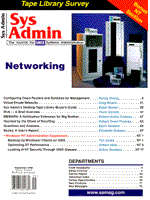
Editor's Forum
What is the hottest network in town? Gigabit Ethernet? Perhaps. Fibre Channel? If considered in terms beyond just a storage interconnect, maybe. Internetworks running IPv6? Still experimental, but shows promise. How about VLANs and VPNs? Potentially, virtual shoo-ins. All of these networking technologies are expanding the ways we can connect systems and people. And, each deserves a slice of our networking mindshare pie. Everyone is talking about VLANs and VPNs, and with good reason. At the local level, VLANs created with Ethernet switches make it easy for network administrators to move people around without opening the door to the wiring closet. After all, where did the monsters that once lived under your bed go when you grew up? VLANs are also a great way of narrowing collision domains, creating virtual subnets of operationally related people with minimal administrative hassle. Taking the concept a step further, sprinkling the right software on servers, clients, and ISP systems lets you extend the LAN to remote sites. A great boon for both road warriors and customers that are part of your extranet. Whalin's discussion of VPNs in this issue will explore that concept further. Other people see IPv6 as the wave of the future. Certainly by expanding the address space, and getting rid of the network class structure of IPv4, IPv6 will solve many of the problems we are expected to face in the future of the Internet. Classless InterDomain Routing (CIDR) was started as a stop-gap method of solving part of the problem while waiting for the roll-out of IPv6. CIDR is working so well, however, some are starting to wonder if we will actually need IPv6 after all. I suspect we will, though, considering the dozens of smart, Java-enabled devices each of us will have in the not-too-distant future. Garrett's article on IPv6 in this issue gives more detail. Other articles in this issue look at additional aspects of the current networking scene. As I write this in the middle of June, however, the hottest network around is not based on copper or optical fiber, but rather people. People attending the annual Usenix Technical Conference held this year in New Orleans. Take 1,300 or so of the best minds on the planet, put them all in one hotel, add two days of highly informative tutorials and three days of mind-expanding technical presentations in one of the most entertaining cities around, and you have the best of all networks. Plus, if you consider attendees munching on bagels and danish in the hallways headed for their next session, you might even consider the Usenix conference a stream of bites. If you weren't able to attend this year's Technical Conference, you missed an excellent program. If you aren't already a member of Usenix and SAGE, you should consider joining. You'll likely get more out of the membership than the last couple of books you bought for about the same price. For more information about Usenix membership and upcoming technical programs, visit the organization's Web site at http://www.usenix.org.
Sincerely yours, |